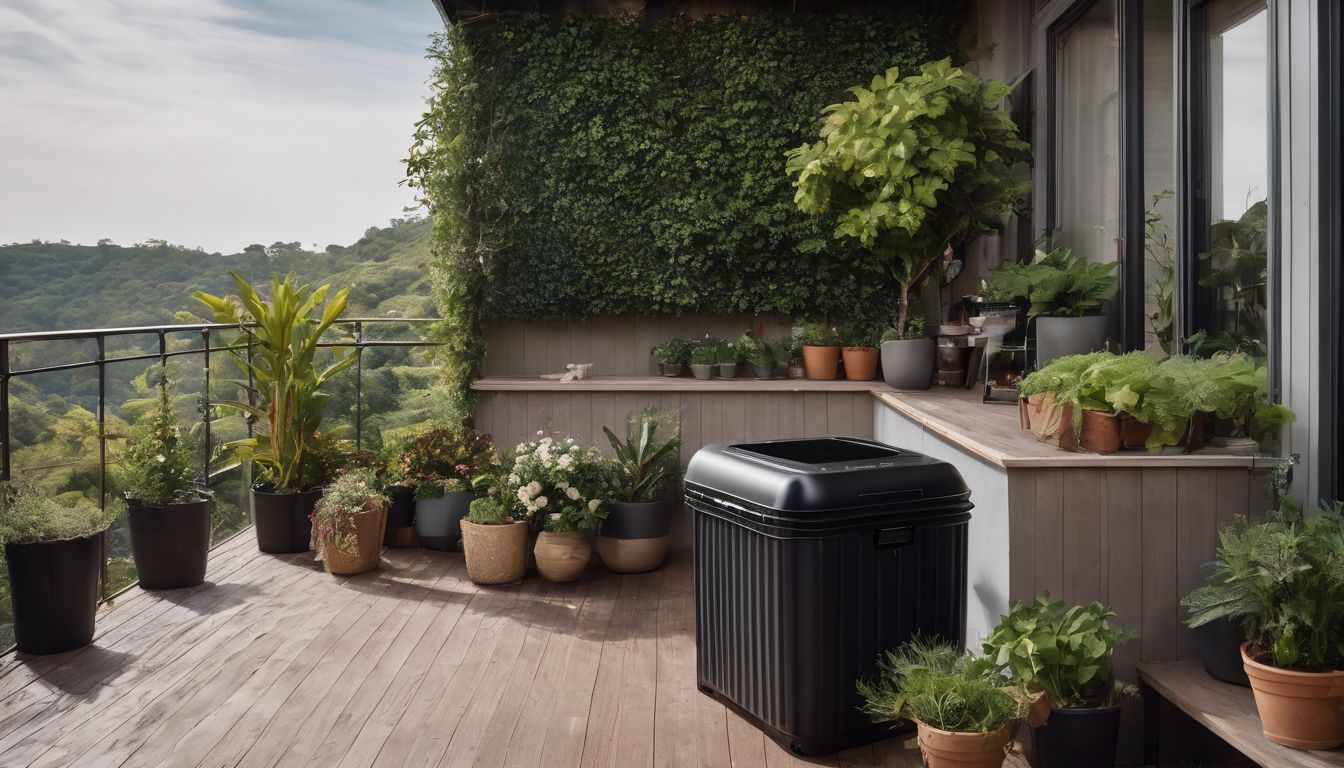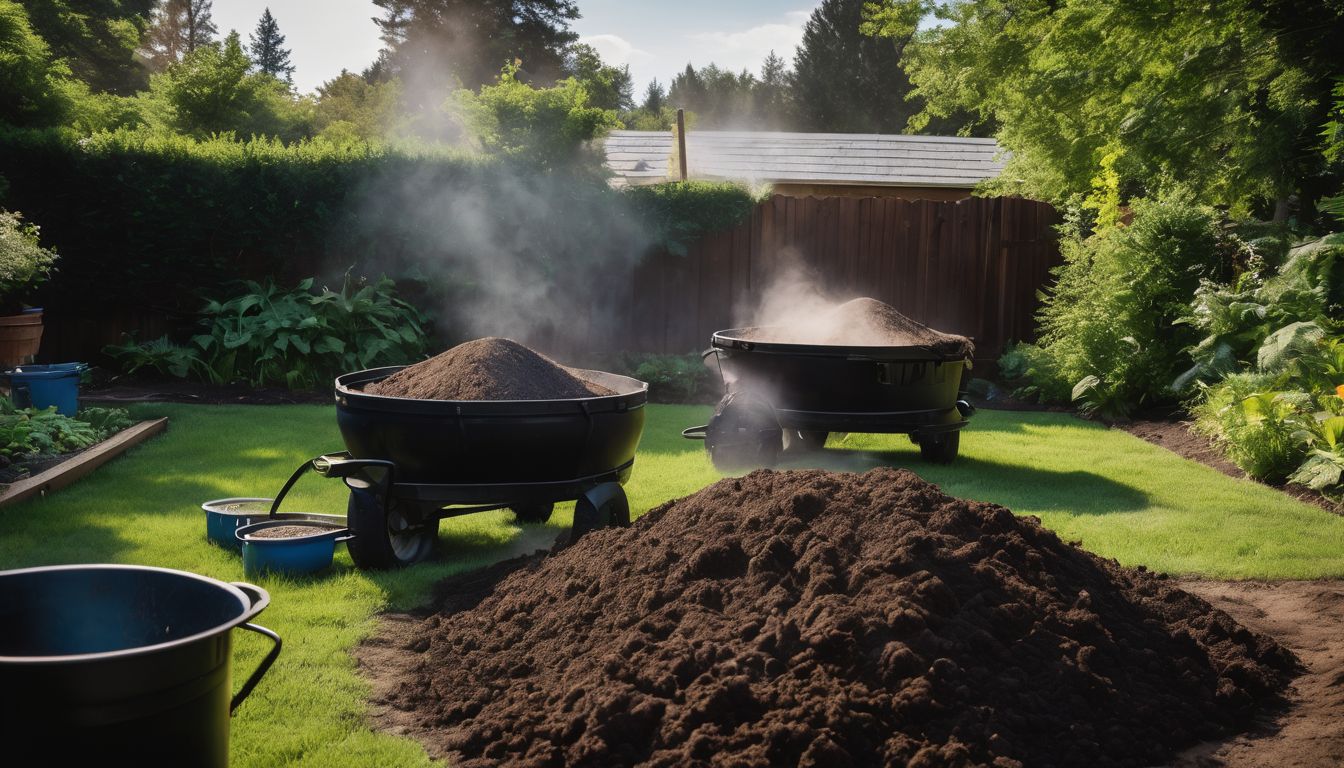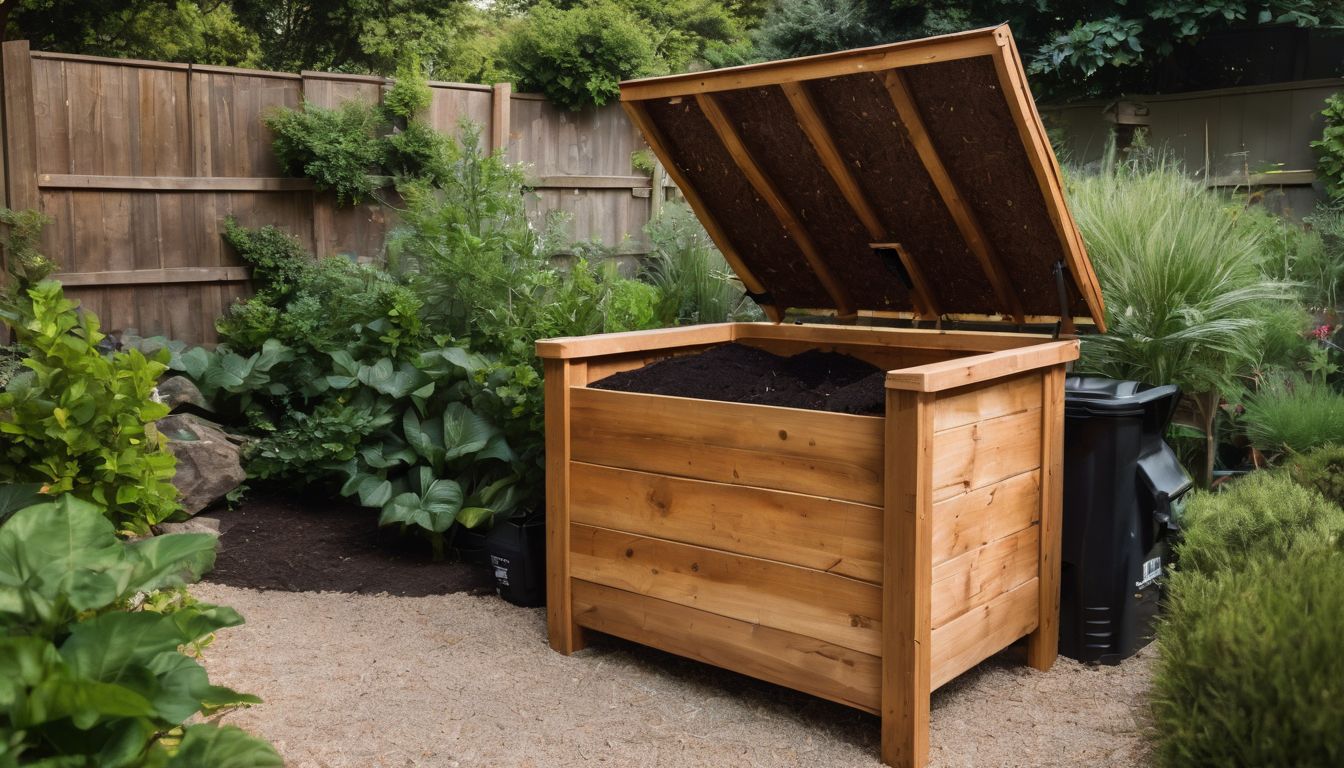Are you wondering what to do with your kitchen scraps and garden waste all year round? Composting is an eco-friendly solution that turns organic remains into nutrient-rich soil. This article guides you through the process of composting in every season, ensuring your garden thrives and waste decreases.
Let’s dig in!
Key Takeaways
- Composting is a year – round activity that can reduce landfill waste and cut down methane emissions by recycling organic leftovers into soil nutrients.
- Proper composting requires a mix of green (nitrogen-rich) and brown (carbon-rich) materials, regular turning for oxygenation, moisture control, and temperature monitoring to speed up the decomposition process.
- In colder months, composting continues at a slower pace but can be maintained using strategies such as insulation with tarpaulins or straw, regular turning to aerate the heap, and indoor methods like wormeries or bokashi systems.
- Finished compost enriches garden soil with vital nutrients while improving its structure; it’s ideal for use in planting beds, lawns, and even as natural fertiliser through compost tea.
- Sustainable gardening practices benefit from all – seasons composting by providing an environmentally friendly alternative to chemical fertilisers and promoting biodiversity in gardens.
Benefits of Composting Throughout the Seasons
Composting throughout the seasons offers reduced waste, improved soil quality, and sustainable gardening practices. It allows for the efficient recycling of organic materials and promotes nutrient cycling in the garden.
Reduced waste
Reducing waste is a key advantage of composting throughout the seasons. Each time you add organic scraps from your kitchen or green waste from your garden to the compost pile, you’re diverting material from landfills.
This helps cut down methane emissions, as organic waste in landfills decomposes without oxygen and creates this greenhouse gas. By recycling food scraps and yard debris through composting, you not only lessen the burden on landfill sites but also transform unwanted leftovers into valuable nutrients for enriching the soil.
Improved soil quality naturally follows this eco-friendly effort to minimise rubbish. As we contribute less to waste streams and more to our gardens, we enhance sustainability with every handful of compost applied.
Let’s delve into how this process boosts soil health next, ensuring that our gardening practices support a thriving ecosystem year-round.
Improved soil quality
Reducing waste through composting not only benefits the environment but also enriches the soil. Decomposed organic matter from compost adds essential nutrients to the soil, enhancing its fertility and promoting healthier plant growth.
Compost acts as a natural soil conditioner, improving its structure, moisture-retention capacity, and overall health. This sustainable practice of recycling biodegradable materials results in reduced landfill waste while fostering lush, thriving gardens and sustainable practices for year-round organic waste management.
Implementing seasonal composting tips ensures that your garden is continuously enriched with nutrient-dense compost to support healthy plant growth throughout the year.
Sustainable gardening
Sustainable gardening supports healthy ecosystems by reducing the use of chemicals and promoting biodiversity. It involves using natural fertilisers, such as compost, to enrich the soil, conserve water, and minimise waste.
Incorporating sustainable gardening practices not only benefits your garden but also contributes to a healthier environment.
By adopting sustainable gardening methods throughout the seasons, you can reduce organic waste through composting and improve soil quality without relying on synthetic fertilisers.
Utilising organic waste recycling ensures that nutrients are returned to the soil, creating a self-sustaining cycle that supports plant growth and resilience in all seasons.
Spring Composting
During spring, the ideal conditions for composting include warmer temperatures and increased microbial activity. You can use a variety of materials such as grass clippings, kitchen scraps, and garden waste to start building your compost pile.
Additionally, incorporating a good balance of green and brown materials will help you achieve successful composting throughout the season.
Ideal conditions for composting
Composting thrives in warm, moist environments. Turning the compost regularly speeds up decomposition. Beneficial microorganisms thrive in oxygen-rich conditions, aiding the breakdown of organic matter.
It’s essential to maintain a balance of green and brown materials for optimal results. The ideal temperature range for composting is between 110°F and 160°F, ensuring that decomposition occurs at an efficient pace.
Moisture levels also play a crucial role; the compost should be damp, like a wrung-out sponge. Proper aeration allows for the necessary airflow to facilitate decomposition although excessive moisture can impede this process.
Materials to use
Spring is not the only season great for composting. As you gather materials for your compost, consider using a mix of green and brown materials. Here are some key items to include in your compost:
- Fruit and vegetable scraps
- Coffee grounds and filters
- Grass clippings
- Leaves
- Straw or hay
- Shredded newspaper or cardboard
- Eggshells
Tips for successful composting
To ensure successful composting throughout the seasons, follow these pro tips:
- Layer green and brown materials to maintain a balanced mix.
- Turn the compost pile regularly to aerate and speed up decomposition.
- Keep the compost pile moist, but not waterlogged, by watering as needed.
- Chop or shred larger materials to facilitate quicker breakdown.
- Avoid adding meat, dairy, or oily foods to prevent odors and pests.
- Use a compost thermometer to monitor temperature levels for optimal decomposition.
- Cover the compost pile with a tarp in winter to retain heat and protect it from excessive moisture.
Summer Composting
During the summer, it’s important to maintain your compost pile and harvest finished compost for use in your garden. Read more to learn effective techniques for successful summer composting.
Maintaining your compost
To maintain your compost heap effectively, follow these key steps:
- Turn the compost regularly to aerate it and ensure even decomposition of materials.
- Check the moisture level of the compost regularly and add water if it becomes too dry.
- Use a pitchfork or compost aerator to mix the materials thoroughly, helping to break up clumps and promote decomposition.
- Cover the compost with a tarp or lid to retain heat and moisture, especially during heavy rainfall or snowfall.
- Monitor the temperature of the compost heap regularly to ensure optimal conditions for decomposition.
- Remove any large pieces of material that may slow down the composting process, such as branches or oversized food scraps.
Harvesting and using finished compost
Fall Composting
Prepare your compost for the winter months by utilising autumn leaves and garden debris to enrich the soil, maintaining a healthy balance of green and brown materials. Read more about how to effectively manage your compost pile throughout the autumn season.
Preparing compost for winter
Prepare your compost for winter by following these steps:
- Cover the compost pile with a tarp or thick layer of straw to insulate it from the cold.
- Mix in fall leaves and garden debris to create a well – balanced mix that will decompose slowly over the winter months.
- Keep turning the compost regularly to aerate it and speed up decomposition, ensuring that it stays active even during the colder weather.
- Consider using indoor composting methods such as vermicomposting or bokashi to continue processing organic waste throughout the winter.
Making use of fall leaves and garden debris
Utilise fallen leaves and garden debris to enrich your compost during the autumn months. Incorporate dry leaves into the compost pile to add carbon-rich material. Shred the leaves to help them break down faster. Mix in small twigs and chopped-up garden waste, ensuring they are well-distributed throughout the pile. Integrate green material, such as grass clippings or kitchen scraps, to balance the carbon-to-nitrogen ratio. Turn the compost regularly to aerate and combine the layers effectively, aiding in decomposition. Keep the compost moist but not soggy by watering it occasionally. Cover the pile with a tarp or lid to retain heat and moisture, promoting decomposition even during colder weather.
Winter Composting
The colder months may slow down the composting process, but there are strategies for successful winter composting and indoor methods to continue managing your organic waste. Learn how to maintain your compost pile in the winter and utilise effective composting techniques for all seasons.
Read more about it on our blog!
Slower composting process
In winter, the colder temperatures slow down the composting process. Microorganisms that break down organic matter are less active in cold weather. To maintain your compost pile, consider covering it with a tarp or insulating material to retain heat and keep moisture in.
By turning the compost regularly and using smaller particle sizes, you can help speed up decomposition during this slower season.
To promote a faster breakdown of materials, consider adding nitrogen-rich green waste and smaller food scraps to balance out carbon-heavy brown materials like fallen leaves or straw.
Strategies for successful winter composting
To ensure successful winter composting, consider the following strategies:
- Protect your compost heap from harsh weather conditions by covering it with a tarpaulin or plastic sheet to retain heat and moisture.
- Use insulating materials like straw or shredded newspaper to layer and cover the compost heap, preventing it from freezing entirely.
- Mix in ‘hot’ or nitrogen – rich materials such as kitchen scraps and coffee grounds to maintain decomposition activity during colder temperatures.
- Turn the compost heap regularly to aerate and mix the contents, promoting decomposition even in winter.
- Consider using a smaller, insulated bin for indoor composting if outdoor conditions are too extreme, continuing to manage organic waste throughout the season.
Utilizing indoor composting methods
To successfully compost indoors during the winter, consider using a worm bin or bokashi system. Both are efficient methods for processing organic waste in limited space.
- Worm Bin: Vermicomposting using red worms is perfect for indoor composting. Place shredded paper, cardboard, and kitchen scraps in the bin to create nutrient-rich vermicompost.
- Bokashi System: This anaerobic fermentation method utilises a special bran mix to break down food waste. The fermented material can then be added to outdoor compost or buried directly in soil.
- Odour Management: Properly maintaining your indoor compost system minimises unpleasant smells. Keep the container sealed and add a layer of carbon-rich material like shredded paper or sawdust after each addition of food waste.
- Moisture Control: Ensure that your indoor compost stays moist but not wet by regularly checking the moisture content and adding water as needed.
- Harvesting Compost Tea: Both worm bins and bokashi systems produce nutrient-dense liquid that can be used as a fertiliser on houseplants or outdoor garden beds.
- Managing Space: Consider available space, temperature regulation, and aesthetic considerations when deciding which indoor composting method works best for you.
Conclusion
In summary, composting throughout the seasons offers a sustainable solution for reducing waste and improving soil quality. It provides year-round benefits for gardeners and environmentally conscious individuals.
Embracing cold weather composting, maintaining the pile, and using effective techniques ensure successful composting in all seasons. Those who seek to enrich their soil while managing organic waste can adopt these strategies throughout the year.
FAQs
1. What is composting throughout the seasons?
Composting throughout the seasons involves applying techniques and best practices to manage your compost pile all year, enriching soil even during colder weather.
2. Can I still compost in cold weather?
Yes, you can practice cold composting by maintaining your compost pile regularly to ensure it breaks down organic waste effectively, even in winter.
3. How do I maintain my compost pile during winter?
To maintain your winter compost pile, keep adding layers of yard waste and occasionally turn it to help with decomposition despite the chilly temperatures.
4. Are there special strategies for winter gardening and composting?
Indeed, implementing seasonal organic waste management strategies ensures effective year-round enriching of garden soil through ongoing composter maintenance.
5. Does a compost heap work differently across various seasons?
A well-managed heap adjusts to seasonal changes; effective composing in all seasons may require varying levels of attention based on temperature and organic material availability.





